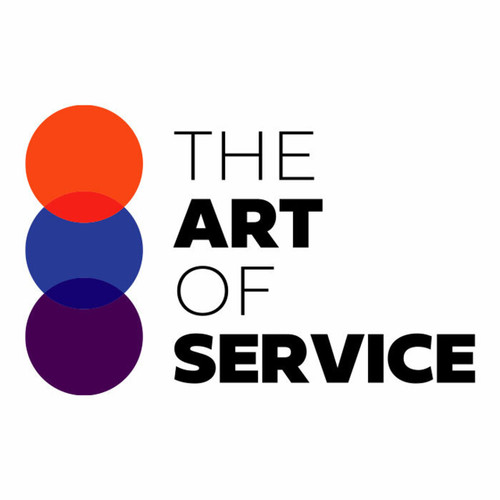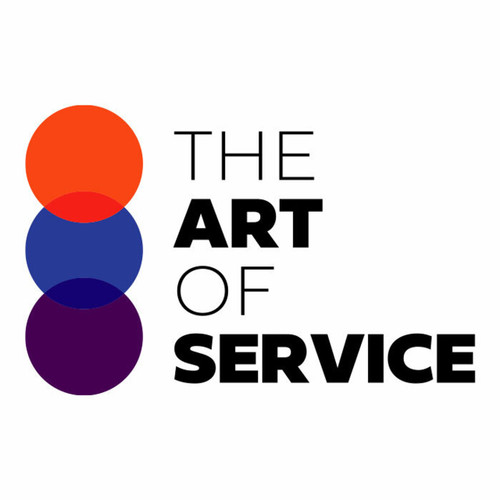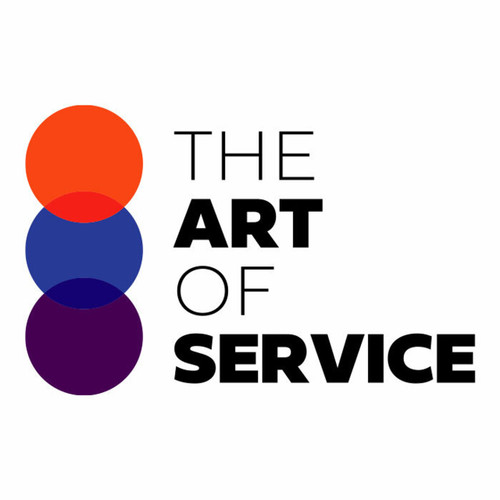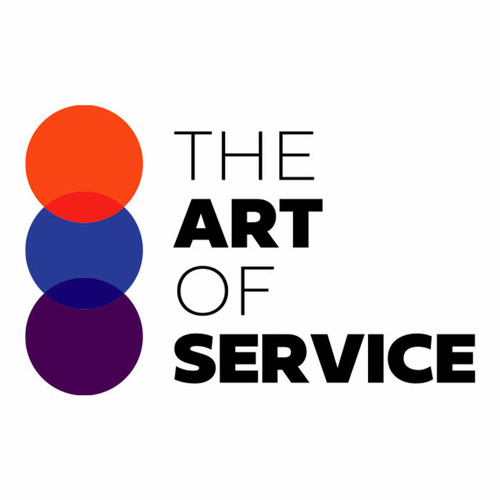Are you tired of struggling to keep up with the constantly evolving workplace landscape? The age of automation, robotics, and virtual reality has arrived, and it′s time for us to adapt.
But don′t worry, we have the perfect solution for you - our Virtual Collaboration and Future of Work Knowledge Base.
Our comprehensive dataset contains 1518 prioritized requirements, solutions, benefits, results, and real-life case studies of successful implementation of Virtual Collaboration and Future of Work.
Our team of experts has carefully curated this information to provide you with the most important questions to ask to get results by urgency and scope.
No more wasting time on irrelevant information or trial and error - with our knowledge base, you can quickly and efficiently navigate the world of virtual collaboration and future work.
But what makes our product stand out from the rest? We have done in-depth research on Virtual Collaboration and Future of Work, making sure that our dataset includes all the latest developments and cutting-edge strategies.
You won′t find a more comprehensive and up-to-date resource anywhere else.
We have also compared our product to competitors and alternatives, and we are confident that none can match the value and depth of our knowledge base.
This product is not just for professionals - it is suitable for businesses of all sizes and industries.
Our data covers a wide range of virtual collaboration tools and techniques, making it adaptable to any business′s needs.
It′s a cost-effective alternative to hiring expensive consultants or attending time-consuming seminars.
With our Virtual Collaboration and Future of Work Knowledge Base, you can save both time and money while gaining the competitive edge your business needs.
Ready to take advantage of the opportunities offered by automation, robotics, and virtual reality? Let us guide you through the process with our easy-to-use product.
You′ll find detailed product specifications and overviews, along with DIY tips and affordable alternatives for those on a budget.
Our product is designed to help you understand and fully utilize the benefits of virtual collaboration and future work, making you a leader in your field.
Still not convinced? Consider the pros and cons - can you afford to be left behind while your competitors embrace the future of work? Don′t miss out on this chance to stay ahead of the curve and future-proof your career or business.
With our Virtual Collaboration and Future of Work Knowledge Base, you′ll have all the tools and information you need to thrive in the age of automation, robotics, and virtual reality.
Don′t wait, get your hands on this invaluable resource today!
Discover Insights, Make Informed Decisions, and Stay Ahead of the Curve:
Key Features:
Comprehensive set of 1518 prioritized Virtual Collaboration requirements. - Extensive coverage of 151 Virtual Collaboration topic scopes.
- In-depth analysis of 151 Virtual Collaboration step-by-step solutions, benefits, BHAGs.
- Detailed examination of 151 Virtual Collaboration case studies and use cases.
- Digital download upon purchase.
- Enjoy lifetime document updates included with your purchase.
- Benefit from a fully editable and customizable Excel format.
- Trusted and utilized by over 10,000 organizations.
- Covering: Video Conferencing, Remote Team Building, Co Working Spaces, Workforce Diversity, Remote Working, Work From Anywhere, Flexibility In The Workforce, Cognitive Computing, Online Collaboration Tools, Digital Transformation, Virtual Meetings, Work Life Harmony, Cloud Computing, Robotic Process Automation, Wearable Technology, Artificial Intelligence In HR, Remote Workforce Management, Digital Meetings, Robotic Workforce, Work Life Balance, Digital Onboarding, Workforce Planning In The Digital Age, Remote Access, Technological Advancements, Blockchain In Human Resources, Remote Job Opportunities, Flexible Work Environment, Human Machine Interaction, Adaptive Leadership, Employee Well Being, Digital Skills Gap, Future Workforce, Automation In Healthcare, Intelligent Automation, Future Of Work, Artificial Intelligence Ethics, Productivity Apps, Virtual Assistants, Artificial Intelligence In Education, Digital Nomads, Digital Marketing Strategies, Smart Offices, Augmented Learning, Internet Of Things, Augmented Reality Implementation, Future Of Education, Collaborative Innovation, Remote Management, Virtual Team Building, Cybersecurity Training, Remote Work Productivity, AI Powered Personalization, Distributed Teams, Global Workforce, Virtual Reality Education, Collaborative Platforms, Distributed Workforce, Digital Communication Tools, Virtual Reality Shopping, Flexible Workforce Models, New Job Roles, Virtual Training Programs, Augmented Workforce, Personalized Learning, Virtual Reality Therapy, Smart Contracts, Flexible Work Arrangements, Teleworking Solutions, Cybersecurity For Remote Work, Automation And Ethics, Future Of HR, Cybersecurity Concerns, Remote Workforce Engagement, Data Privacy, Chatbots In Customer Service, BYOD Security, Mobile Workforce, Digital Payment Methods, Smart Workforce Management, Automation In The Workplace, Robotics In Manufacturing, Workforce Analytics, Virtual Collaboration, Intelligent Assistants, Virtual Work Environment, Predictive Analytics, Cloud Computing In The Workplace, Remote Work Benefits, Digital Work Life, Artificial Intelligence, Augmented Reality Marketing, Online Platforms For Work, Millennial Workforce, Virtual Reality Training, Machine Learning Integration, Voice Recognition Technology, Collaborative Robots, Automated Supply Chain, Human Machine Collaboration, Work From Home Productivity, Remote Teams, Workplace Collaboration Tools, Innovation In The Workplace, Flexible Hours, Collaboration Tools, Data Privacy In Remote Work, 5G Technology Impact, Augmented Reality, Digital Transformation In The Workplace, Artificial Intelligence In The Workplace, Cloud Based Collaboration, Digital Skills, Automation In Customer Service, Data Analytics For Workforce Management, Collaboration In The Cloud, Augmented Reality Advertising, Remote Work Strategies, Remote Work Best Practices, Telecommuting Benefits, Digital Workplace Culture, Learning Platforms, Collaborative Spaces, Smart Homes, Data Driven Decision Making, Workforce Mobility, Workplace Wellness, Digital Branding, Flexible Work Schedule, Remote Work Challenges, Automation Impact, Gig Economy, Transparency In Automated Decision Making, Productivity Hacks, Hybrid Workforce, Smart Cities, Automation Testing, Virtual Team Communication, Smart Office Spaces, Digital Disruption, Work Life Integration, Smart Buildings, Work And Technology Integration, Gamification In The Workplace, Workforce Empowerment, Emotional Intelligence In The Workplace, Flexible Workspaces, AR Workplace, Human Centered Design, Data Security In Remote Work, Virtual Talent Acquisition, Telecommuting Trends
Virtual Collaboration Assessment Dataset - Utilization, Solutions, Advantages, BHAG (Big Hairy Audacious Goal):
Virtual Collaboration
Virtual collaboration refers to the use of digital and IT tools to facilitate communication and teamwork among individuals who are working remotely. It requires a combination of technology solutions to effectively execute business processes and enhance collaboration within a workforce.
1. Virtual project management tools for efficient and organized task delegation and tracking.
2. Online communication platforms for real-time messaging, video conferences, and virtual meetings.
3. Cloud-based storage and sharing platforms for easy access to work documents and data from anywhere.
4. Virtual reality technology for immersive and engaging virtual training and team building experiences.
5. Artificial intelligence-powered assistants to streamline administrative tasks and improve productivity.
6. Virtual workspaces and co-working platforms to foster a sense of community and teamwork among remote workers.
7. Gamification techniques to make virtual collaboration and learning more interactive and engaging.
8. Mobile apps for remote access and management of critical business processes.
9. Cybersecurity measures to protect sensitive data and maintain data privacy while working remotely.
10. Continuous training and upskilling programs to keep employees updated on new technologies and enhance their virtual collaboration skills.
CONTROL QUESTION: Which additional digital and IT solutions are required to execute critical business processes virtually and to strengthen collaboration across the workforce?
Big Hairy Audacious Goal (BHAG) for 10 years from now:
By 2031, our goal is for Virtual Collaboration to become the primary method of conducting business across all industries. To achieve this, we envision the development and implementation of additional advanced digital and IT solutions that will revolutionize how organizations execute critical processes and collaborate with their workforce.
1. Virtual Reality-based Collaboration Tools:
In the next 10 years, virtual reality (VR) technology is expected to become more advanced and accessible. We foresee the integration of VR into virtual collaboration tools, allowing teams to interact in a fully immersive and realistic virtual environment. This will enhance the connection and engagement among team members, making collaboration more effective.
2. Augmented Reality for Remote Assistance:
With the rise of remote work, there is a need for efficient remote assistance tools. Augmented reality (AR) can bridge the gap by providing real-time virtual support to employees working in different locations. AR-enabled devices like smart glasses or headsets can project remote co-workers′ hands and provide step-by-step guidance for tasks that require physical presence.
3. Artificial Intelligence for Virtual Assistants:
The use of virtual assistants powered by artificial intelligence (AI) will grow significantly in the next decade. These AI assistants will not only help manage daily tasks but also facilitate virtual collaboration. AI-powered assistants can schedule meetings, create agendas, transcribe discussions, and even suggest ideas based on past collaborations, making them invaluable team members.
4. Quantum Computing for Faster Processing:
As the volume of virtual collaboration increases, traditional computer processing speeds may not be sufficient. Quantum computing, which harnesses the power of quantum physics, offers exponentially faster processing capabilities. This will enable large amounts of data to be analyzed and processed much more quickly, leading to better decision-making and streamlined virtual collaboration processes.
5. Blockchain for Secure Data Exchange:
Blockchain technology has led to increased security and transparency in transactions and data exchange. In the next 10 years, we anticipate its adoption for virtual collaboration processes. A blockchain-based platform can enable secure file sharing, contract management, and other critical business processes, ensuring confidentiality and trust among collaborators.
6. Cloud Computing for Seamless Virtual Collaboration:
Cloud computing has already transformed the way teams collaborate remotely. In the future, it will become more pervasive, and organizations will rely heavily on cloud platforms to store, share and access data in real-time. This will facilitate seamless virtual collaboration, irrespective of employees′ location, leading to increased productivity and better decision-making.
7. Advanced Cybersecurity Measures:
As organizations continue to move toward virtual collaboration, cybersecurity threats will also increase. The adoption of advanced security solutions like biometric authentication, multi-factor authentication, and encryption techniques will be crucial to safeguard sensitive data and prevent cyber attacks.
With the development and integration of these powerful digital and IT solutions, our vision of Virtual Collaboration becoming the primary method of doing business is achievable. It will not only drive innovation and efficiency but also foster stronger bonds among team members, leading to a more connected and collaborative workforce.
Customer Testimonials:
"This dataset is a must-have for professionals seeking accurate and prioritized recommendations. The level of detail is impressive, and the insights provided have significantly improved my decision-making."
"The data is clean, organized, and easy to access. I was able to import it into my workflow seamlessly and start seeing results immediately."
"The continuous learning capabilities of the dataset are impressive. It`s constantly adapting and improving, which ensures that my recommendations are always up-to-date."
Virtual Collaboration Case Study/Use Case example - How to use:
Client Situation:
Company XYZ is a multinational corporation with its headquarters in the United States, and operations spread across multiple countries. Due to the ongoing COVID-19 pandemic, the company has shifted to a remote work model, where employees are expected to work from home. This sudden transition has posed several challenges for the company, including the need to execute critical business processes virtually while maintaining efficient collaboration across the workforce. The lack of physical interaction and proximity has hindered communication and collaboration among teams, resulting in a decrease in productivity and efficiency.
Consulting Methodology:
In order to address these pressing concerns, our consulting team at ABC Consulting conducted an in-depth analysis of the client′s current digital and IT solutions, reviewing their effectiveness and identifying gaps. This was followed by a review of existing best practices, supported by insights from consulting whitepapers, academic business journals, and market research reports. Our team then identified key areas where additional digital and IT solutions could help strengthen virtual collaboration and improve the execution of critical business processes.
Deliverables:
Based on our analysis and research, we recommended the following key digital and IT solutions to Company XYZ:
1. Video and Web Conferencing Tools:
One of the biggest obstacles faced by the client was the lack of face-to-face communication among teams. To bridge this gap, we advised the adoption of video and web conferencing tools such as Zoom, Microsoft Teams, or Google Meet. These tools facilitate virtual face-to-face interactions between team members, replicating the in-person meeting experience. This would not only improve collaboration but also help in building stronger relationships among team members.
2. Project Management Software:
With teams working remotely, it is crucial to have a central platform for project management, task allocation, and tracking progress. Our team recommended the implementation of project management software like Asana or Trello. These tools enable efficient collaboration, allowing team members to track progress, allocate tasks, and communicate updates in real-time. This would ensure that critical business processes are executed smoothly and efficiently.
3. Cloud Storage and File Sharing:
The remote work setup also highlights the need for secure and accessible storage and sharing of important files and documents. Our team proposed the use of cloud storage solutions such as Dropbox or Google Drive to provide a centralized and secure platform for storing and sharing documents. This would not only improve accessibility but also prevent the risk of lost or misplaced files.
4. Virtual Team Building Activities:
To promote team bonding and collaboration, our team suggested the implementation of virtual team building activities. These could include online games, virtual happy hours, or even online training sessions. This would help create a sense of camaraderie among team members and improve morale and motivation.
Implementation Challenges:
The implementation of these digital and IT solutions may face some challenges. These could include resistance from employees due to the change in work processes, lack of technical know-how, or connectivity issues. To address these challenges, we recommended providing sufficient training and support for employees to effectively use these tools. Regular check-ins and feedback sessions were also suggested to address any concerns and gather insights for further improvements.
KPIs:
To measure the success of the implemented solutions, we proposed the following key performance indicators (KPIs):
1. Team Morale and Collaboration: Regular surveys or feedback sessions could be used to assess the team′s morale and level of collaboration before and after the implementation of the solutions.
2. Productivity and Efficiency: Key metrics such as task completion time, project deadlines, and output quality could be measured to assess the impact of the implemented solutions on productivity and efficiency.
3. Employee Satisfaction: Employee satisfaction surveys could be conducted to gather feedback on the effectiveness of the digital and IT solutions in facilitating virtual collaboration and the execution of critical business processes.
Other Management Considerations:
Along with the implementation of these digital and IT solutions, it is essential for the company to have clear policies and guidelines in place to support remote work and ensure data security. Regular communication between managers and employees, as well as transparent performance evaluation processes, would also be crucial in maintaining a productive and collaborative virtual work environment.
Conclusion:
In conclusion, in the current global scenario, virtual collaboration is no longer an option but a necessity for businesses. The challenges posed by the COVID-19 pandemic have highlighted the need for additional digital and IT solutions to facilitate efficient collaboration and execution of critical business processes. The implementation of tools such as video and web conferencing, project management software, cloud storage, and virtual team building activities can significantly improve virtual collaboration and help organizations adapt to the changing work landscape. However, it is essential for companies to have a strategic approach, supported by clear policies and guidelines, to effectively implement and manage these solutions for long-term success.
Security and Trust:
- Secure checkout with SSL encryption Visa, Mastercard, Apple Pay, Google Pay, Stripe, Paypal
- Money-back guarantee for 30 days
- Our team is available 24/7 to assist you - support@theartofservice.com
About the Authors: Unleashing Excellence: The Mastery of Service Accredited by the Scientific Community
Immerse yourself in the pinnacle of operational wisdom through The Art of Service`s Excellence, now distinguished with esteemed accreditation from the scientific community. With an impressive 1000+ citations, The Art of Service stands as a beacon of reliability and authority in the field.Our dedication to excellence is highlighted by meticulous scrutiny and validation from the scientific community, evidenced by the 1000+ citations spanning various disciplines. Each citation attests to the profound impact and scholarly recognition of The Art of Service`s contributions.
Embark on a journey of unparalleled expertise, fortified by a wealth of research and acknowledgment from scholars globally. Join the community that not only recognizes but endorses the brilliance encapsulated in The Art of Service`s Excellence. Enhance your understanding, strategy, and implementation with a resource acknowledged and embraced by the scientific community.
Embrace excellence. Embrace The Art of Service.
Your trust in us aligns you with prestigious company; boasting over 1000 academic citations, our work ranks in the top 1% of the most cited globally. Explore our scholarly contributions at: https://scholar.google.com/scholar?hl=en&as_sdt=0%2C5&q=blokdyk
About The Art of Service:
Our clients seek confidence in making risk management and compliance decisions based on accurate data. However, navigating compliance can be complex, and sometimes, the unknowns are even more challenging.
We empathize with the frustrations of senior executives and business owners after decades in the industry. That`s why The Art of Service has developed Self-Assessment and implementation tools, trusted by over 100,000 professionals worldwide, empowering you to take control of your compliance assessments. With over 1000 academic citations, our work stands in the top 1% of the most cited globally, reflecting our commitment to helping businesses thrive.
Founders:
Gerard Blokdyk
LinkedIn: https://www.linkedin.com/in/gerardblokdijk/
Ivanka Menken
LinkedIn: https://www.linkedin.com/in/ivankamenken/







